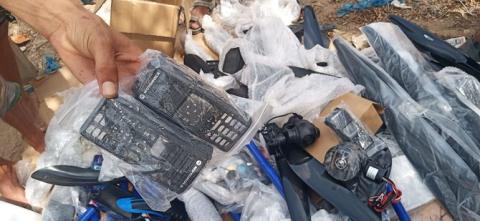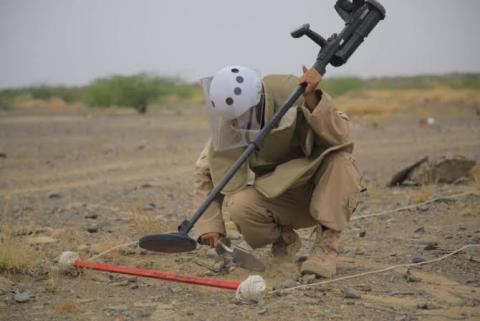From southern Lebanon to Yemen: Houthi rebels deploy 'rock mines' first used by Israel


Landmines recovered during clearing operations in Yemen support the long-held belief that Houthi rebels are using technology and know-how exported by other Iran-allied groups in the region to manufacture weapons, experts say.
Yemen is considered one of the world’s most mined countries after nearly eight years of war, although the exact number remains unknown.
Deminers in Yemen have come across mines disguised as stones and boulders that are similar to those used by Israel in Lebanon, said mine action veteran Chris Clark.
He believes Hezbollah in Lebanon, which — like the Houthis — is backed by Tehran, learnt to build similar devices and subsequently exported knowledge and components to Yemen.
“The conclusion wasn’t too hard to come to that Hezbollah is supporting the Houthis with technical training and support,” Mr Clark said.
Mr Clark said he first encountered these “rock mines” while for working for the UN in southern Lebanon, after Israel's withdrawal in 2000.
This followed nearly a decade of fighting forces led by Hezbollah.
“They were basically invented or originally designed by the Israelis,” he said.
“Southern Lebanon is a mountainous area so the Israelis would sit in fortified positions on top of a hill and command the area while having direct fire machine guns.”
“But because the terrain is so rocky, there were certain places they couldn’t watch. Hezbollah forces, who know the ground well, would use these hidden spots in the wadis and sneak up on the Israeli positions.”
A former Lebanese National Army official stationed in southern Lebanon in 2003 confirmed the existence of these Israeli-made mines.
“They would be hidden under rocks so as not to be detected, especially at night, when visibility was low,” he told The National.
“We often would raise awareness about their existence, especially to farmers, who lived and operated in those areas,” he said.
Now, as director of special operations at the Saudi Project for Landmine Clearance (Masam), Mr Clark says he is seeing an even deadlier version of these rock mines in Yemen — specifically, in areas retaken from the Houthis by government forces.
“We are encountering copies that are basically the same concept but made locally,” he said.
“They are better quality than the ones from Lebanon and also incorporate infrared beams as a trigger mechanism.”
Masam says about 80 per cent of the nearly 136,000 mines it has cleared were locally made.
“This begs the question as to where the component parts are coming from,” Mr Clark said.
Mr Clark believes the know-how to assemble and manufacture these mines came from Hezbollah.
“I saw these appear again a little bit after the war in Lebanon in Iraq, in areas where we knew Iran was using Hezbollah to support some of its insurgency activities in Iraq. Then we started to find them in Yemen.
The Lebanese military source could not confirm that Israeli mines fell into the hands of Hezbollah, but did not rule out the possibility.
“I imagine, as part of the resistance, Hezbollah would have spotted these mines, like we did at the time.”

Yemeni officials on Monday condemned arrests and prosecutions by the Iran-backed Houthi militia directed against media, journalists and celebrities…

Yemen's warring parties are gearing up for new waves of conflict in 2023 amid a lack of decisive steps towards sustainable peace, adding to the suf…

The UAE will help to recruit doctors and deliver crucial supplies for hospitals in Yemen under a major healthcare drive. The Khalifa bin…